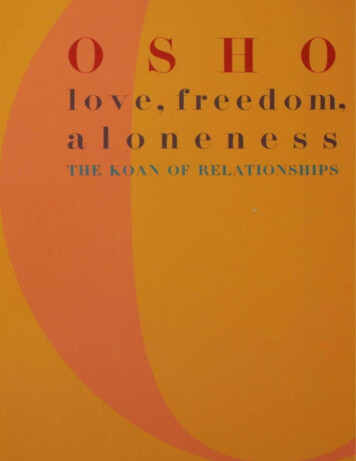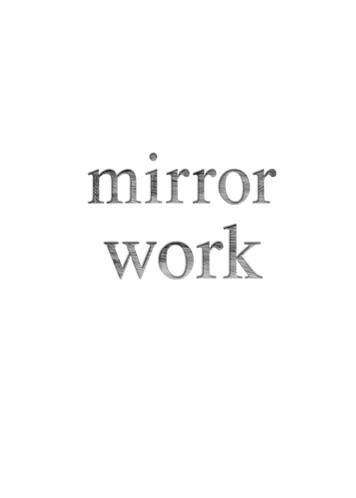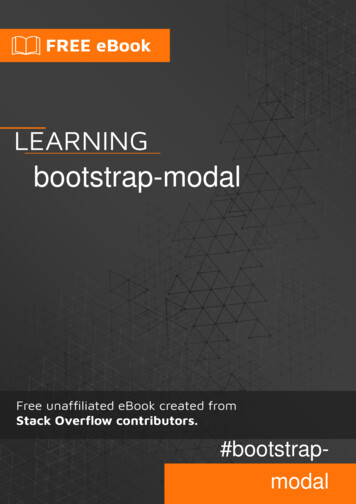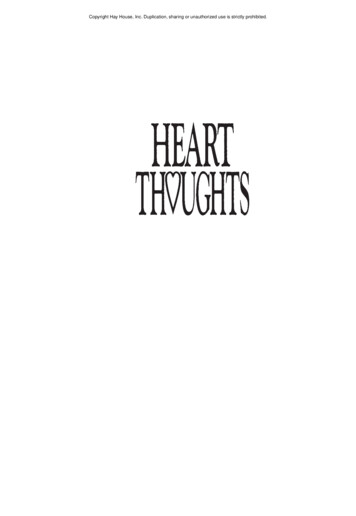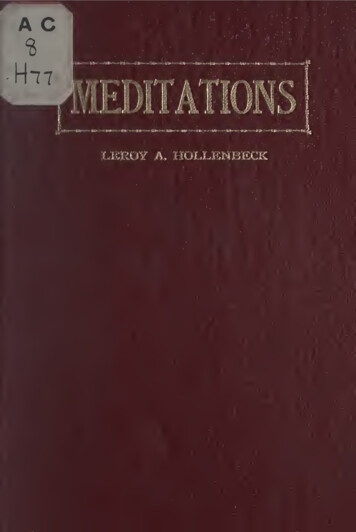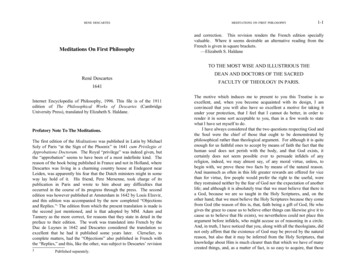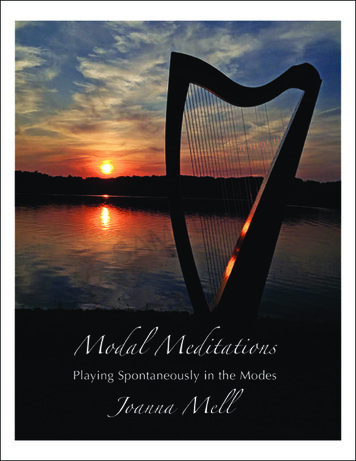
Transcription
SASELPM
Modal MeditationsThis book is a sequel to "Modal Musings: Modes & Music", which outlines andanalyzes each of the seven contemporary modes. I highly recommend that you becomevery familiar with the material in "Modal Musings" before embarking on the material inthis book. A working knowledge of the modes and music theory is helpful to understanding and using the material in this book. The intent of this book is to provide avariety of arpeggios and musical phrases to enhance the musician's repertoire forspontaneous composition. I hope that these offerings will inspire the reader inspontaneous playing and give rise to new compositions of the reader's own making.The modes provide the musician with a varied palette of harmonies and tonalcolors with which to create compositions with unique musical moods and atmospheres.The modes consist of collections of pitches which form scales. The Ionian mode isfamiliar to musicians as the modern major scale, and the Aeolian mode is familiar as themodern natural minor scale. The rest of the modes (Dorian, Phrygian, Lydian,Mixolydian and Locrian) are familiar to the modern Western musician as altered majorand minor scales.SELPEach mode consists of seven notes. It is of utmost importance to understand thatthese notes do not exist in a vacuum. Each note has a relationship with the note that isthe tonal center of the mode, creating a harmonic interval. Each note also may form aharmonic interval with another note in the modal scale, especially when played as achord. These harmonic intervals determine the identity, nature, and characteristics ofeach mode. Chord progressions are very helpful in creating the "modal atmosphere"because they establish a framework in which the mode is experienced by the listener.Therefore, it is essential that the musician understands and becomes familiar with theharmonies created in each mode. To this end, I have included many examples of chordprogressions and musical phrases for each mode in the book. I highly recommend thatthe reader become familiar with and memorize these patterns so that a repertoire iscreated that will become a great resource in spontaneous playing and composition.MSAWhen using this book, I suggest playing through the chord progressions usingblock chords at first, and then playing the chords in arpeggio patterns, both in 3/4 timeand 4/4 time. The variations on the arpeggio patterns are endless, and only a few areincluded here. I encourage the musician to experiment with the patterns, rearrangingnotes, adding some passing and neighbor tones, and generally being as creative aspossible. For the therapeutic musician, the use of arpeggios is valuable, as they can beused in harmonic patterns to soothe, calm, and uplift. In this way, musical compositionsunfamiliar to the patient can be created.I hope the material in this book inspires you in your new musical journeys. Joanna Mell 2015. All rights reserved.Unauthorized duplication prohibited.
Playing Spontaneouslyin the ModesMusic is a gift that has been given to all of us by our Creator. It lives deep insideeach person's soul and spirit - it cannot be manufactured. Some people have a greater giftfor creating new musical compositions than others; however, the gift can be cultivated,nurtured, and strengthened. Creating spontaneous musical compositions comes verynaturally to small children. Children enjoy making up games on the playground andthese are often accompanied by rhymes and tunes. Children naturally absorb the musicof the culture that is all around them. They use these learned patterns and musicalframeworks to create their own songs. Unfortunately, as people age chronologically, thisgift is pushed aside and too often becomes buried and neglected as society createspressure to excel in other areas. The gift is always there, however, just as water flowsunderground without our awareness of it. This resource often bubbles up spontaneouslyas a spring; at other times, we must dig deep wells and work harder at bringing it to thesurface.SELPIn my own experience as a creative musician, I have found that the gift forspontaneous composition has been nurtured by the many songs and pieces that I havelearned over the years. I have learned musical patterns in my studies of folk music andclassical music, and these patterns form the basis for spontaneous composition.Therefore, I am including many of these patterns in this book and sharing them with you,the reader, to give you a repertoire of musical phrases and patterns to form a frameworkupon which you may weave your own spontaneous compositions. Most musicalcompositions consist of chord patterns and melodies built upon short scales and chordtones and the greater our repertoire is, the deeper the reservoir will be when we wish tocreate our own compositions.MSAI suggest that you start with the easier patterns and commit them to memory (getthem "by heart") and then move on to learn the more advanced patterns and phrases.Eventually, you will start playing some of these patterns and a new pattern will come intoyour fingers. There are no strict rules when it comes to playing spontaneously.However, it is helpful when one can start with a framework of a chord progression, muchas the weaver sets up the loom before starting to weave the piece. I like to think of theprocess as a plane taxiing down a runway, gradually picking up speed, and then lifting offthe ground to soar in the air. The musical phrases and patterns in the musician'ssubconscious can provide wings to soar. Joanna Mell 2015. All rights reserved.Unauthorized duplication prohibited.
Aeolian Meditationqt5qt9qt ERççå çç çç ççRççWçQç çççå çç çç R Wqç ç çåtçå çç çç R WEçç ç çç çQç çç çççç ç çç ç çQRçççå çç çç çççççç ç çRçEççå çç R W Joanna Mell 2015. All rights reserved.Unauthorized duplicaton prohibited.ç çç ççç ç ççç çQç çEç çç ç çQç R Wç ç ççç çESELPMSAç ççç çEç ç ç ç çQ13çç çç R WRçå çç ççç ç çç ç R W çEAeolian4/4ç ç çç çQç çç ç ççQç ç
Dorianiq Wt5 ç ç Wtçç WWçqt13 çççVIIq tçççSAççç ççççç çççççWWç i çWççi çiSELPMVII VIIIV ççWç WiçWIII ççW ç WVIIi9ççWiq W4/4IViVIIçççç çç Joanna Mell 2015. All rights reserved.Unauthorized duplication prohibited.ççWç ç
Dorian4/4iVII17q tç21qt25çEççç W çEçiçççEççi tçççEççiq tççççEççW ççEçIV q29ç ççEççSAWçEççEEçç çççEç çEWççEç çi çç VIIVII ççSELPM çç W ççΩ çE Joanna Mell 2015. All rights reserved.Unauthorized duplication prohibited.çΩWçEç
Dorian4/4iVII33qEtç37qtç ç ççEçEçWç ç ççEççWIVç ç ççEçW41qEtçç ç ççEçEçWç ç ççç ççç ç ççEWEçç ç ççEçWçççç ç ççEçWSELPMSAçEç ççç ç çEEçWçEtEçWçç ççç ç ççEçWç ç ççç ççç ç ççEWç ççç ç ççççEWç ççç ç çEççEWç Joanna Mell 2015. All rights reserved.Unauthorized duplication prohibited.WEWå R çEçEçç ççç ç ç45qEçiEçEçç R W
Ionian3/4I5q Et ç ç ç R t9Rççå çEEERçç Rçt13qtEçRçç çå çEç ç RçRççç ç REEåç çç RviçRççç REçRçç Rççå çEçç Rçççå çEEEçå çRç RçRçç çå çREçERçå ççç çREVEçERç Rçççå ççEVRççRçiiççRçIVviEIVçççå çRçç ç SELPMç ç EVEçESAEçççå çRiiEçVEviIqç ççåRç çç RIqIIVçç Joanna Mell 2015. All rights reserved.Unauthorized duplication prohibited.çå çREçççWçç RE
Lydian4/4IIIq Wt ç WçWWqWtçqWtççççW çççWç çç ç çWççWççWç ççWççWç çWçW Joanna Mell 2015. All rights reserved.Unauthorized duplication prohibited.IIIç ç çç ç ΩΩWIç çç ç ç ISA çSELPM çWçII WWçVIt ç13qçIII9 WççI5 WççIçç ç
Mixolydian Meditation59q t ç q tçqçotç13qçtçQç ççEçå çççEççQçEçççççEççESAçç çEçççEçç çE oçççSELPM çç ççEç ç çQQç ççoMixolydian3/4çççEçççççE oççççççççç Joanna Mell 2015. All rights reserved.Unauthorized duplication prohibited.EçEEQççççå ççoçEççE
Phrygian Meditation59q Et ç qçotçqçot13qt17qtç çWçççççççççççRç RçççççRç Rç ç çoççççççççç çççç ç SELPMSAçç çWçoçå çççç ç ççççç çççç ç çoçç ççççç Joanna Mell 2015. All rights reserved.Unauthorized duplication prohibited. EççWço Eçççç ç çoçççå ççoççç ç ç EPhrygian3/4ççWçççççRç Rç oçççR oççççç ç ç Rç
Phrygian3/421qtçoççoç ç ççççoç ç ççççç25qt29qtçå ççoççççoççççtçççt EççWçç EççWççççççççSELPMçççççå ççççççç EçWç oççç oçç oQçoçå çç37qççoççç ç ççå ççoçSAç33qççoç ç çççç oçå ççoçå ççQççç Eçç Joanna Mell 2015. All rights reserved.Unauthorized duplication prohibited.Wçç o o o
Modal Meditations This book is a sequel to "Modal Musings: Modes & Music", which outlines and analyzes each of the seven contemporary modes. I highly recommend that you become very familiar with the material in "Modal Musings" before embarking on the material in this book. A working kno
